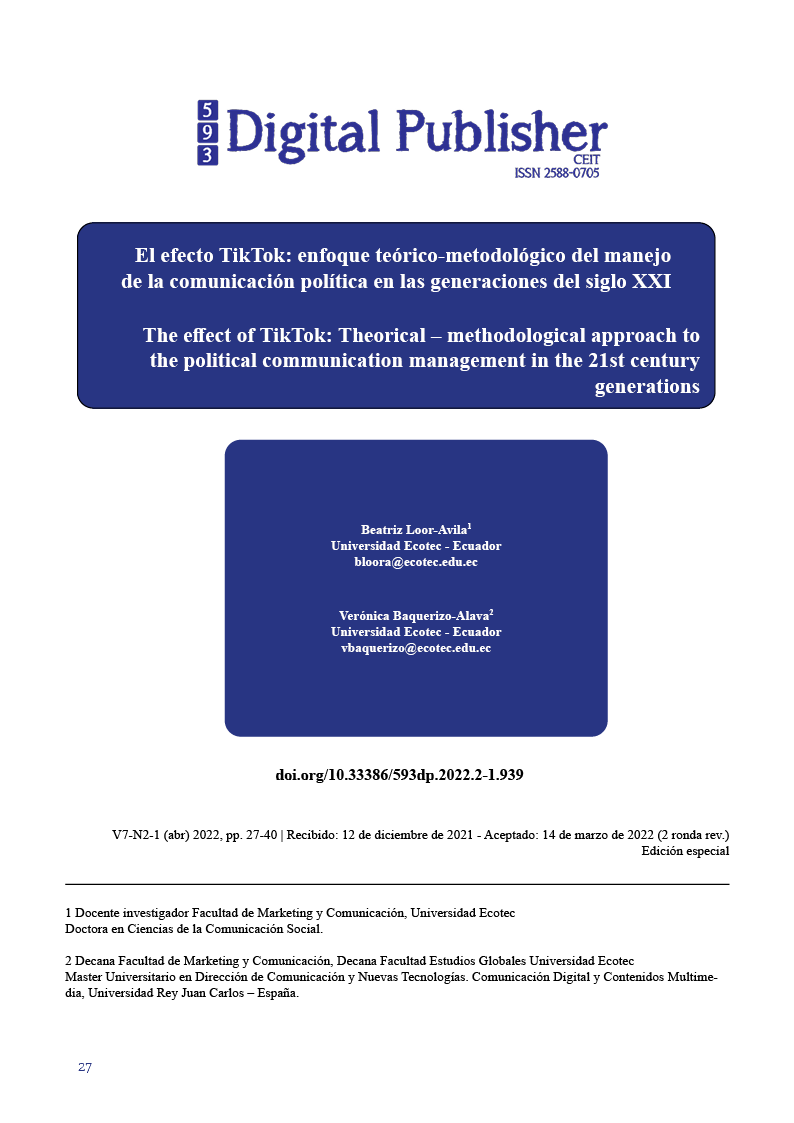El efecto TikTok: enfoque teórico-metodológico del manejo de la comunicación política en las generaciones del siglo XXI
Contenido principal del artículo
Resumen
Los autores de la presente investigación analizan la incidencia de las plataformas digitales de comunicación en las generaciones votantes del siglo XXI. Lo cual desemboca en una nueva forma de percibir y manejar la comunicación política. El estudio se enfoca principalmente en la red social TikTok y cómo el uso y el efecto de esta plataforma generó empatía y aceptación en los diversos sectores del país. El principal problema, una postura de rechazo a la política de exposición de discursos pasivos, superficiales, desconectados de la realidad de la juventud, lo que presenta aún, estos modelos tradicionales y esquemas socioculturales y políticos ambiguos, que fueron los detonantes para la desmotivación y desinterés de los votantes y se formula la pregunta ¿cuál es el enfoque teórico metodológico que sustenta el uso de la herramienta TikTok en el manejo de la comunicación política en las nuevas generaciones en el Ecuador? Por tal razón, surge la necesidad de presentar nuevos escenarios comunicacionales en el marketing de una política moderna, donde la importancia de las redes sociales ha tomado fuerza a través de la generación de nuevos contenidos. Como objetivo principal analizar el impacto de las campañas políticas presidenciales ecuatorianas en los jóvenes votantes y usuarios de TikTok. En el Ecuador, para las elecciones presidenciales del año 2021 varios candidatos hicieron uso de esta plataforma, intentando comunicar su mensaje de gobierno por este medio, así como también mostrando sus actividades realizadas durante el periodo de campaña. El enfoque metodológico basado en la revisión de la literatura considerando que estamos en una investigación de revisión teórica. Todos estos antecedentes provocan un nuevo protagonismo por parte de la nueva sociedad, el efecto TikTok, a través de la participación ciudadana, la solidaridad da un claro ejemplo de construir un mundo mejor con políticas públicas que favorecen a las nuevas generaciones como los principales protagonistas de la historia.
Descargas
Detalles del artículo

Esta obra está bajo una licencia internacional Creative Commons Atribución-NoComercial-CompartirIgual 4.0.
1. Derechos de autor
Las obras que se publican en 593 Digital Publisher CEIT están sujetas a los siguientes términos:
1.1. 593 Digital Publisher CEIT, conserva los derechos patrimoniales (copyright) de las obras publicadas, favorece y permite la reutilización de las mismas bajo la licencia Licencia Creative Commons 4.0 de Reconocimiento-NoComercial-CompartirIgual 4.0, por lo cual se pueden copiar, usar, difundir, transmitir y exponer públicamente, siempre que:
1.1.a. Se cite la autoría y fuente original de su publicación (revista, editorial, URL).
1.1.b. No se usen para fines comerciales u onerosos.
1.1.c. Se mencione la existencia y especificaciones de esta licencia de uso.
Citas
Altamirano, V. y Túñez, M. (2014). Promoción y Difusión Turística en Iberoamérica. Análisis de contenidos y herramientas utilizadas en portales web y redes sociales. VI Congreso Internacional Latina de Comunicación Social – VI CILCS – Universidad de La Laguna. Tenerrife, España.Andrade, F. (2019). Universidad de Guayaquil. Obtenido de http://repositorio.ug.edu.ec/bitstream/redug/41550/1/An%c3%a1lisis%20de%20la%20Comunicaci%c3%b3n%202.0%20en%20la%20Campa%c3%b1a%20Pol%c3%adtica%20Presidencial%20Ecuador-2017%20.pdf
Barquero, C. (2015). Comunicação estratégica. Madri: McGrawHill.
Briones, S. 2021 https://cromaclictv.com/tik-tok-la-estrategia-de-comunicacion-de-lasso/
Calderón, D., Enciso, G., y Arias, C. (2017). Manual de Marketing Político. Bogotá: Universidad Santo Tomás.
Campos. (2015). Digital Future in Focus Global 2015. Recuperado de https://www.comscore. Com/Insights/Presentations-and-Whitepapers/2015/2015-Global-Digital-Future-inFocus
Campos R. (2021) Adaptado de “Aprobación de los mandatarios América y el mundo” Ranking Mitofsky.
Carlsson, E., y Nilsson, B. (2016). Technologies of participation: Community news and social media in Northern Sweden. Journalism: Theory, Practice y Criticism, 17(8), 1113–1128. http://doi.org/10.1177/1464884915599948
Consejo Nacional Electoral - CNE (2021). Resultados Elecciones Generales en Ecuador primera vuelta 2021
CNE (2019). Elecciones seccionales de 2019. Obtidoemhttp://cne.gob.ec/es/?option=com_contentyview=articleylayout=edityid=4593 https://cromaclictv.com/tik-tok-la-estrategia-de-comunicacion-de-lasso/
Cruz, L. (26 de marzo de 2019). Merca 2.0. Obtenido de https://www.merca20.com/delmarketing-politico-tradicional-al-digital/
Durán Barba, Felipe Noguera, James L. Garnett, Hannia Vega, Roberto Izurieta. Ecuador Estado Digital (2021). Estadística de usuarios de redes sociales en Ecua-dor.
Ecuador Verifica. (2021). Ecuador Verifica. Obtenido de http://ecuadorverifica.org/2021/03/09/tiktok-campanas-electorales-ecuador/
Estrategias de Comunicación para Gobiernos. F.B.T. Quito-Ecuador. 2001. Washington D.C. junio 2001
El Universo. (24 de mayo de 2020). Hasta en TikTok los políticos buscarán los votos en Ecuador, COVID-19 cambia la estrategia electoral para elecciones 2021. El Universo.
Fernández, Y. (7 de abril de 2021). Xataja Basics. Obtenido de https://www.xataka.com/basics/que-tiktok-donde-viene-que-ofrece-red-socialvideos
Flores Garcés, Roger Danilo (2018)
URI: http://repositorio.puce.edu.ec:80/xmlui/handle/22000/18011
García, J. (2015). Marketing Político. Segovia: Universidad de Valladolid.
Hernández, C. (2019). Scielo. Obtenido de
http://www.scielo.org.mx/scielo.php?script=sci_arttextypid=S018519182019000100327
Howard, P., Savage, S., Flores-Saviaga, C., Toxtli, C. & Monroy Hernández, A. 2017. Redes Sociales, Compromiso Cívico Y La Hipótesis Del Slacktivismo: Lecciones De “El Bronco” De México.
Hujanen, J. (2016). Participation and the Blurring Values of Journalism. Journalism Studies, 17(7), 871–880.
Ibero. (1 de julio de 2020). Posgrados Ibero. Obtenido de https://blog.posgrados.ibero.mx/comunicacion-politica/ Baggionlini, L., & Castro, S. (24 de octubre de 2016). Universidad Nacional del Rosario. Obtenido de https://revistas.ort.edu.uy/inmediaciones-de-lacomunicacion/article/view/2621/2606
IAB Spain Marketing, IX Estudio de redes sociales 2018, s.p. Url: https://marketing4ecommerce.net/estudio-de-redes-sociales-espana-2018/Jordán, J., López, M., Soria, M., y Chasipanta, A. (2020). Factores integrales del marketing político. Análisis de redes sociales. 593 Digital Publisher CEIT, 5(2), 180-189.
Manosevitch, I., y Tenenboim, O. (2017). The Multifaceted Role of User-Generated Content in News Websites. Digital Journalism, 5(6), 731–752.
Nulty, Paul, Theocharis, Yannis , Popa, Sebastian Adrian , Parnet, Olivier and Benoit, Kenneth (2016) Redes sociales y comunicación política en las elecciones de 2014 al Parlamento Europeo. Estudios Electorales, 44. pp. 429-444. ISSN 0261-3794Peña, B. (2016).
Pulso Ciudadano (2021). Encuesta de intención del voto para primera vuelta Elecciones Generales en Ecuador 2021.
Sanz, M. (2019). Computer Hoy. Obtenido de https://computerhoy.com/reportajes/tecnologia/que-es-microtargeting-487077
Sánchez, S. (2020). Universidad de Valencia. Obtenido de https://www.researchgate.net/profile/Joao-Sousa-27/publication/351625196_Redes_sociais_online_exposicao_digital_e_cyberbullying_perfis_de_vulnerabilidade_de_universitarios_de_Cabo_Verde/links/60a22b5792851cfdf33ba6e1/Redes-sociais-online-exposicao-digital
Sánchez, C. (2017). Manual de Marketing Político. Colombia:
Ediciones USTA.
Van Dijck, J (2016), La cultura de la conectividad: Una historia critica de las redes sociales. Buenos Aires: Veitiuno Editores.
Villi, M., y Noguera-Vivo, J.-M. (2017). Sharing media content in social media: The challenges and opportunities of user-distributed content (UDC). Journal of Applied Journalism y Media Studies, 6(2), 207–223. http://doi.org/10.1386/ajms.6.2.207_1
Vives, M. (2020). Universidad de La Sabana. Obtenido de https://intellectum.unisabana.edu.co/bitstream/handle/10818/43403/Trabajo%20de%20grado%20Valentina%20Vives.pdf?sequence=1yisAllowed=y



